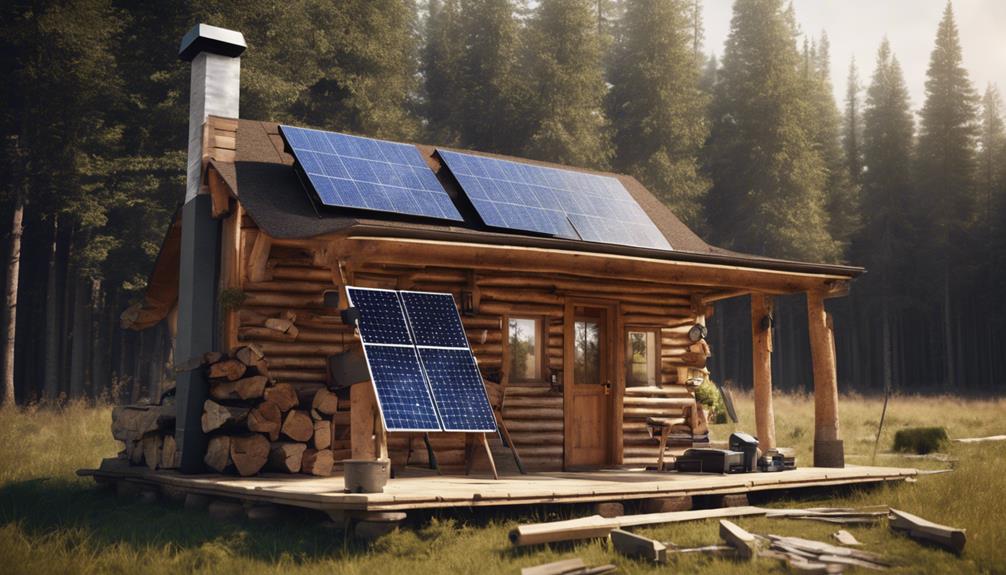When tackling DIY cabin solar panel installation, focus on high efficiency and durability for long-term performance gains. Thoroughly analyze your electricity usage patterns and appliance wattage to size the system correctly. Optimize sun exposure by installing panels where they receive maximum sunlight, minus any shading obstructions. Ensure safety during installation by evaluating the roof's structure and completing expert panel mounting. Safely connect the panels to your cabin's electrical system for maximum off-grid benefits. Remember, attention to detail can lead to a successful solar setup.
Choosing the Right Solar Panels
When selecting solar panels for your cabin installation, prioritize efficiency and durability to ensure optimal performance and longevity. Panel efficiency is crucial as it determines how much sunlight the panels can convert into electricity. Higher efficiency panels may cost more initially but can save you money in the long run by generating more power from the same sunlight. Consider the balance between panel efficiency and cost to find the best option for your cabin.
Brand reliability plays a significant role in the longevity and performance of your solar panels. Opt for reputable brands known for producing high-quality and reliable products. Check customer reviews and ratings to gauge the brand's reputation in the market. Additionally, a good warranty is essential to protect your investment. Look for solar panels with robust warranties that cover not only manufacturing defects but also performance guarantees. A solid warranty ensures that you can rely on your solar panels for years to come.
Assessing Your Cabin's Energy Needs
To accurately determine the energy requirements of your cabin, conduct a detailed assessment of your daily electricity usage patterns and specific power needs. Start by performing an energy audit to understand your power consumption throughout the day. Consider the appliances and electronics you use, their wattage, and the average hours they run. This information will help you calculate the total energy your cabin consumes daily.
Living off the grid requires a sustainable energy approach. Look into renewable sources like solar power to meet your cabin's electricity needs. Solar panels can provide clean energy, reducing your environmental impact.
When assessing your energy requirements, factor in not only the essential appliances but also any additional devices you plan to use. Understanding your power needs is crucial for sizing your solar panel system correctly.
Planning the Panel Placement
Consider the optimal placement of solar panels on your cabin's roof to maximize sun exposure and energy production efficiency. To achieve this, assess the direction your roof faces and aim to install the panels where they'll receive the most sunlight throughout the day.
Ensure that there are no obstructions such as trees, buildings, or other structures that could cast shadows on the panels, as shading can significantly reduce energy output.
Additionally, think about future maintenance when planning the panel layout. Position the panels in a way that allows for safe and easy access for cleaning and maintenance. Regular cleaning is essential to ensure the panels operate at peak efficiency.
Panels covered in dirt, debris, or snow won't be able to convert sunlight into electricity effectively. By strategically planning the placement of your solar panels, you can optimize sun exposure, minimize shading issues, and simplify maintenance tasks, ultimately maximizing your cabin's solar energy production.
Installing the Solar Panels
Assess the structural integrity of your cabin's roof to determine its capacity to support the weight of the solar panels before proceeding with the installation process. Safety precautions are paramount during this phase. Make sure you have the necessary tools such as a drill, mounting brackets, bolts, and a ladder to safely install the panels.
Begin by positioning the mounting brackets on the roof according to your pre-planned layout and secure them in place. Lift the solar panels onto the brackets carefully, ensuring they're aligned correctly for optimal sun exposure.
When installing the panels, be cautious of your footing, especially on sloped or elevated roofs. Use appropriate safety gear like harnesses if needed. Once the panels are securely in place, double-check all connections and brackets for stability.
Regular panel maintenance is crucial for optimal performance. Clean them periodically and inspect for any damage. If troubleshooting is needed, check the wiring connections and consult the manufacturer's guidelines for common issues.
Connecting to Your Cabin's Electrical System
Ensure a seamless integration of your cabin's solar panel system with your electrical setup by expertly connecting the panels to your cabin's electrical system. When connecting the solar panels, prioritize safety precautions to prevent accidents. Before beginning any electrical wiring, ensure that the power from the solar panels is properly shut off. Use appropriate safety gear such as gloves and goggles, and work methodically through each step of the connection process.
Once the solar panels are connected, consider battery storage as a crucial component of your off-grid system. Implement maintenance tips such as regularly checking the battery levels and ensuring proper ventilation around the battery storage area to prevent overheating. Additionally, keep the batteries clean and free of debris to maintain their efficiency and longevity.
Properly connecting your cabin's solar panels to the electrical system is essential for maximizing the benefits of your off-grid setup. By following safety protocols and incorporating maintenance practices for battery storage, you can ensure a reliable and sustainable power source for your cabin.
Conclusion
In conclusion, with the right solar panels and careful planning, you can successfully install a DIY solar panel system for your cabin. By assessing your energy needs and strategically placing the panels, you can maximize efficiency and savings.
Remember, the sun is a powerful resource just waiting to be harnessed for your energy needs. So take the time to plan and install your solar panels with precision, and watch your cabin become a beacon of sustainable living.
